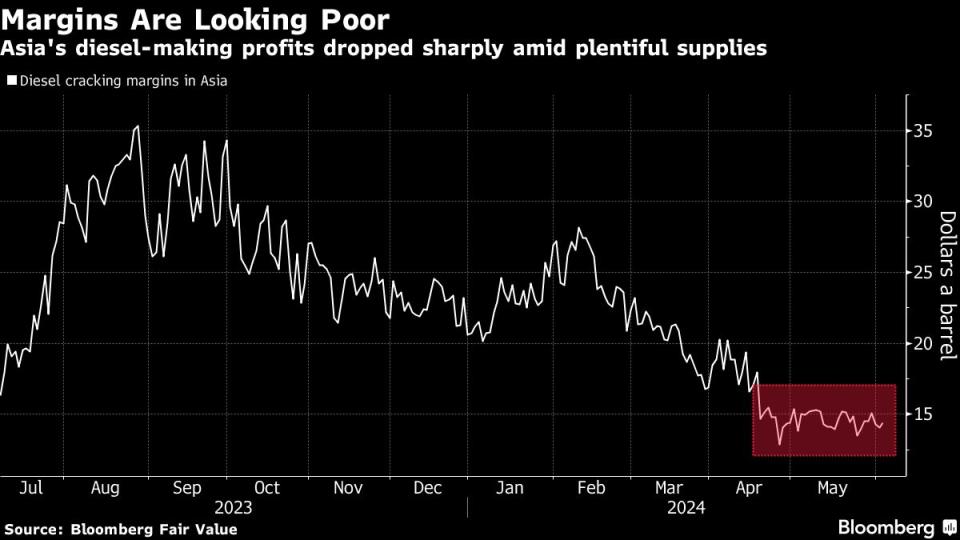OPEC+ Supply Move Spooks Oil Traders Still Waiting for Summer

(Bloomberg) -- OPEC+’s surprise decision to return oil supply to the market later this year has alarmed traders of physical cargoes, who say there’s limited evidence yet of a long-awaited improvement in the global market that would justify the move.
Most Read from Bloomberg
Modi Vows to Retain Power Even as Party Loses India Majority
BlackRock, Citadel Back Texas Stock Exchange in Challenge to NYSE
Short Sellers in Danger of Extinction After Crushing Stock Gains
Indian Stocks Lead Gains in Asia as Modi Ally Pledges Support
On Sunday, the Organization of Petroleum Exporting Countries and its allies announced that eight nations within the alliance would from October gradually restore 2.17 million barrels a day of supply that they’ve been voluntarily withholding to prop up prices. Implementation of the decision will take place over a 12-month period and depends on the market at the time.
But traders of physical cargoes said that one driver of the producer group’s decision — namely that conditions should tighten sharply over the coming summer months — has yet to materialize. That’s not to say an improvement won’t happen: the consensus among financial analysts is that oil stockpiles will whittle away in the coming months, helping to cope with the extra OPEC+ supply when it arrives.
OPEC+ is under pressure from within to unwind huge production cuts that on the one hand have boosted prices but on the other have prevented some nations from expanding their oil industries as they’d planned. Even after some of the curbs get unwound, there will still be millions of barrels being kept off the global market.
For now, though, the day-to-day market where physical cargoes are bought and sold is dominated by signs of a surplus driven in part by lackluster buying from China and elsewhere that’s eating away at trader confidence.
Read also: China’s Oil Demand Outlook Darkens as OPEC+ Prepares to Meet
Weak diesel-making margins have prompted China to pick up lower volumes of Russia’s ESPO crude in China, a popular grade for private processors in the Asian country, with imports on track to tumble to a multi-year low in June. Likewise, some July-loading cargoes of Abu Dhabi’s Upper Zakum crude have had difficulty finding buyers in its main Asian market, according to traders.
In both the North Sea and the US, there are also indications of weakness.
At least six out of eight North Sea’s Forties cargoes that were for May loading are still floating off the UK coast thanks in part to lackluster buying from Asia, traders said. To put it in context, China bought 4 million barrels of this grade for April loading, and 2 million barrels for March.
Several companies have been trying to sell June North Sea grades for a couple of weeks without success while a supertanker with Norway’s Johan Sverdrup and Oseberg crudes ended up unloading in Sweden. It did so after a one-day trip from loading terminals in the North Sea — an extraordinarily short voyage for a vessel designed to transport cargoes over thousands of miles.
Traders also see other signs of bearishness in July-cycle trading. On Monday, two cargoes of Ekofisk and one of Oseberg, both considered premium grades, were entered into what are called forward chains — a mechanism to trade and deliver North Sea crude into the physical market.
Chains are normally used for the cheapest of six benchmark grades - Brent, Forties, Oseberg, Ekofisk, Troll and WTI Midland. Traders said the unusual chaining of two premium crudes suggests the July market might also be weak. These barrels would arrive in Asia in mid-to-later summer.
US Unsold
In the US, millions of barrels of light crude offered for June loading have gone unsold as demand from China ebbs, traders said. Some of those barrels have now been redirected to refiners in the US, where margins remain healthy, and some are slowly clearing to overseas markets at deeper discounts.
On its own, none of the developments are disastrous for OPEC+ or bulls who’re betting the group will prop up the market. But they aren’t indicative of a market that’s turned decisively bullish yet either.
At least three physical traders in Asia said that, while the OPEC+ barrels will only arrive later in the year, they weaken the outlook and mean a softer forward curve that is, in turn, eating into more-immediate prices. Those views were echoed by at least three European and four US traders who pointed to signs of surplus and lackluster Chinese buying.
A key gauge that represents the strength of the Asian market — the premium of Oman crude futures against Dubai swaps — has fallen to 62 cents a barrel on Tuesday, more than halving from a week earlier, as refining margins in Asia tumble to near the lowest since November. Profits from making fuels like gasoline and diesel continue to soften, with increased cargoes from the Middle East and India flooding the market.
Though, there are more encouraging signs on immediate demand from west Africa, an important export area insofar as the region’s barrels can go to all the key demand centers.
Nigerian crude sales improved for June after official selling prices were cut to multi-month lows and European refineries wrapped up seasonal work. Fewer than 10 shipments were left to find buyers, according to traders. Angola’s supply for this month was nearly sold out, they added.
--With assistance from Bill Lehane and Julian Lee.
Most Read from Bloomberg Businessweek
David Sacks Tried the 2024 Alternatives. Now He’s All-In on Trump
Startup Brings New Hope to the Pursuit of Reviving Frozen Bodies
The Budget Geeks Who Helped Solve an American Economic Puzzle
©2024 Bloomberg L.P.

 Yahoo Finance
Yahoo Finance 